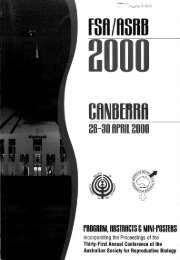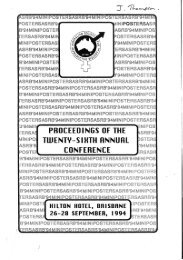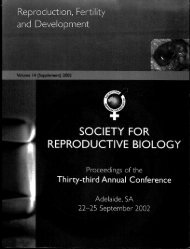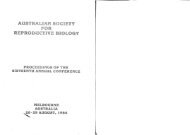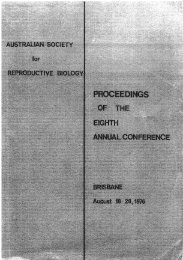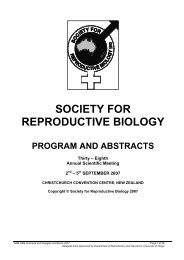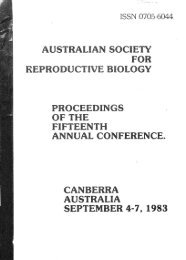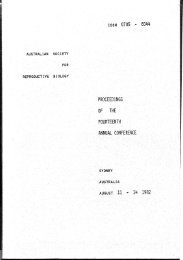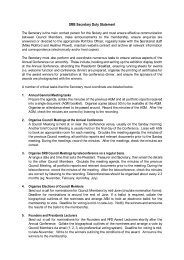N OCIETY' - the Society for Reproductive Biology
N OCIETY' - the Society for Reproductive Biology
N OCIETY' - the Society for Reproductive Biology
Create successful ePaper yourself
Turn your PDF publications into a flip-book with our unique Google optimized e-Paper software.
REGULATION OF PROTEIN TYROSINE PHOSPHORYLATION, DURING IN VITRO AGING OFEJACULATED BOVINE SPERMATOZOA.J. Krzyzosiak1,2*, G. McMillan 1 , R. Vishwanath l and P. Molan 2lUvestock Improvement Corporation, Private Bag 3016, Hamilton, New Zealand, 2Department of Biological Sciences,University ofWaikato, Private Bag 3105, Hamilton, New ZealandINTRODUCTIONTyrosine phosphorylation of various sperm proteinsplays a role in regulation of motility, capacitation, andzona pellucida binding of sperm (1). Reactive oxygenspecies promote tyrosine phosphorylation of spermproteins during capacitation (2). The objective was todetermine if changes in protein-tyrosinephosphorylation occur during in vitro storage, and if<strong>the</strong>y are affected by <strong>the</strong> oxygenation state of <strong>the</strong> storagemedium. The study was extended to determine whe<strong>the</strong>rprotein phosphorylation taking place during storageunder anaerobic and aerobic conditions are reversiblewhen spermatozoa are transferred from oneenvironment to ano<strong>the</strong>r.METHODSSemen collected from three bulls, was diluted in acommercial diluent (CAPROGEN®) (3), divided andstored under anaerobic or aerobic conditions at ambienttemperature (18-20°C). On day 5 of in vitro storage,one half of <strong>the</strong> semen aged under anaerobic conditionswas transferred from an anaerobic chamber to anaerobic environment. Similarly, one half of <strong>the</strong> semenaged under aerobic conditions was transferred to <strong>the</strong>anaerobic chamber. Proteins were extracted from cellsharvested and washed on days 6, 9, and 12 of storageunder <strong>the</strong> four conditions. Tyrosine-phosphorylatedproteins were separated by SDS-PAGE and imrnunodetectedon a Western blot with 4G10 antiphosphotyrosineantibody using an ECL detectionsystem.RESULTSWe observed a time dependent increase in tyrosinephosphorylation of number of proteins under anaerobicbut not under aerobic conditions. When sperm agedunder anaerobic conditions were transferred to <strong>the</strong>aerobic environment, proteins that were phosphorylatedup to this point were dephosphorylated duringsubsequent aerobic incubation. Conversely when sperminitially incubated under aerobic conditions weretransferred to an anaerobic environment, proteins whichdid not display increased protein tyrosinephosphorylation until this point became progressivelyphosphorylated on tyrosine residues (Fig. 1).DISCUSSIONBoth protein tyrosine kinase and phosphatase activitiesare affected by <strong>the</strong> presence of O 2 in <strong>the</strong> medium, but<strong>the</strong> effect is <strong>the</strong> opposite of that which is documented<strong>for</strong> sperm undergoing capacitation (4). Changes intyrosine phosphorylation are very slow (12 days) when78compared to typical receptor mediated tyrosinephosphorylation (15 s), or those observed in ejaculatedbovine, sperm incubated under capacitating conditions(4 h) (1).o 6 9 12 6 9 12 6 9 12 6 9 12Fig. 1 Western blot showing tyrosine-phosphorylatedproteinsfrom: semen aged all <strong>the</strong> time under anaerobicconditions (lanes 2-4), semen aged all <strong>the</strong> time underaerobic conditions (lanes 5-7), semen transferred onday five from an anaerobic to an aerobic environment(lanes 8-10), semen transferred on day five from anaerobic to an anaerobic environment (lanes 11-13).Storage time (days) is displayed under <strong>the</strong> blot.In conclusion, an increase in protein tyrosinephosphorylation during ageing is probably differentfrom <strong>the</strong> one observed during capacitation since, unlike<strong>the</strong> latter, it is inhibited in <strong>the</strong> presence of O 2 and isreversed upon transfer of sperm cells from an anaerobicto aerobic environment. Fur<strong>the</strong>rmore, it occurs across amuch longer time span than capacitation. Theidentification of proteins that undergo tyrosinephosphorylation changes during ageing would enable abetter understanding of <strong>the</strong> role <strong>the</strong>y play in thisprocess.REFERENCESl.Galantino-Homer HL, Visc~nti PE, Kopf GS,BiolofReprod, 1997; 56: 707-719.2.Aitken RJ, Paterson M, Fisher H, Buckingham DW,van Duin M J Cell Sci, 1995; 108: 2017-2025.3.Shannon P, J Dairy Sci, 1965; 48: 1357-1361.4.Aitken R, Buckingham D, Harkiss D, Paterson M,Fisher H, Irvine D, Mol Cell Endocrinol, 1996; 17:8393.THE EFFECT OF IN VITRO STORAGE ON MITOCHONDRIAL MARKER ENZYME ACTIVITYIN BOVINE SPERMATOZOAtD. V. R. Bullen I . 2 , P. MolanI, and R. Vishwanath 2lUniversity of \Vaikato, Department ofBiological Sciences, Private Bag 3105, Hamilton 2001, New Zealand, 2LivestockImprovement Corporation Ltd., Private Bag 3016, Hamilton 2001, New ZealandINTRODUCTIONBovine sperm lose fertility rapidly during in vitrostorage at room temperature. Motility is alsogradually lost but at a notably lower rate (1). It hasbeen proposed that <strong>the</strong> more rapid loss of fertilitymay be due to <strong>the</strong> effects of reactive oxygenspecies (ROS) that may be generated in <strong>the</strong> courseof respiration.As part of a larger investigation into <strong>the</strong> effectsof storage in vitro on various biochemicalparameters of sperm mitochondria, <strong>the</strong> activity ofthree mitochondrial marker enzymes wasmonitored.The enzyme assays described in <strong>the</strong> literaturehave been applied almost exclusively to somaticmitochondria or purified enzymes (2-4). For thisreason, work was firstly carried out to determinewhe<strong>the</strong>r <strong>the</strong> assays could be reliably applied to anenzyme preparation extracted from spermmitochondria. Then, enzyme activity wasmonitored at regular intervals, throughout a periodof storage.The aim of this study was to determine whe<strong>the</strong>r<strong>the</strong> activity of mitochondrial marker enzymes waschanging during <strong>the</strong> storage period and to assess<strong>the</strong> effect of <strong>the</strong> storage conditions (aerobic oranaerobic) on any changes taking place.METHODSSemen was collected from mature Friesian bullsand diluted in 14G buffer (5). The semen wasstored ei<strong>the</strong>r aerobically or anaerobically, at roomtemperature (20°C).Sperm extracts were prepared, <strong>for</strong> use in <strong>the</strong>enzyme assays, by sonicating sperm samples in anextraction buffer containing 200mM Tris, 2%sodium citrate, and 0.1% Triton X-100. Theenzyme activity of sperm extracts were analysed at0,6, 12, and 20 days after collection.Three enzymes were assayed: citrate synthase(2); cytochrome c oxidase (3); ATP syn<strong>the</strong>tase(4).RESULTSOver a period of 20 days <strong>the</strong> activity of bothcitrate synthase and ATP syn<strong>the</strong>tase decreasedsignificantly (<strong>for</strong> both enzymes p < 0.001). Forcitrate synthase <strong>the</strong> difference in storageatmosphere had a significant effect on activity (p =0.005), with activity decreasing more in <strong>the</strong>aerobically stored semen than anaerobically stored.The third enzyme, cytochrome c oxidase, showedan increase in activity over time, with <strong>the</strong>difference in storage atmosphere causing asignificant difference in activity (p = 0.001; Fig. 1).The increase in cytochrome c oxidase activity wassignificant <strong>for</strong> sperm stored anaerobically (p



